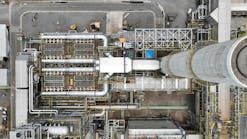India’s IOC plans capacity expansion at Barauni refinery
State-owned Indian Oil Corp. Ltd. (IOC) has informed India’s federal government that it will increase crude oil processing capacity at the company’s 6 million-tonne/year (tpy) Barauni refinery in Begusarai District, Bihar.
IOC will execute the expansion project in two phases, which when completed, will lift processing capacity at Barauni by a total of 3 million tpy to 9 million tpy overall, India’s Minister of Petroleum and Natural Gas (MPNG) Shri Dharmendra Pradhan said in a written notice to the Rajya Sabha, the upper house of India’s Parliament.
Phase 1 of the project will boost capacity by 1 million tpy to 7 million tpy, with the remaining capacity increase of 2 million tpy to be added during Phase 2, according to Pradhan.
The proposed 3 million-tpy expansion at Barauni follows a previous request by the government of Bihar for IOC both to expand processing capacity at the refinery to 15 million tpy and set up a petrochemical complex at the site, according to a series of notifications between MPNG and the government of Bihar.
Following a review of the larger expansion proposal, however, IOC determined that increasing the refinery’s capacity to 15 million tpy as of October 2014 was not “techno-economically” feasible, MPNG said in an Oct. 7, 2014, notice to the government of Bihar.
MPNG earlier informed Lok Sabha, the lower house of India’s Parliament, that IOC’s 2008 proposal to set up a 1.1 million-tpy steam cracker and associated petrochemical complex at Barauni was unviable financially due to the inland refinery’s lack of readily available naphtha supplies, according to a 2010 government report.
While IOC did not respond to OGJ’s request for comments regarding a timeline or budget for the new expansion plans at Barauni, the company currently is assessing capacity augmentation of three crude distillation units at the refinery, MPNG said in a June 12 notice to Bihar’s government.
A detailed configuration study and techno-economic evaluation for Phase 1 of the expansion are under way, with the project scheduled for execution in 2016-17, MPNG added.
A timeline for Phase 2 of the expansion project was not disclosed.
Additional improvements
Despite the tabled proposal to expand Barauni’s capacity to 15 million tpy, IOC continues to proceed with other improvement works designed to boost performance and ensure long-term viability of the refinery, according to MPNG.
As part of its high-sulfur crude maximization (HSCM) project, IOC has undertaken a revamp of the refinery’s 600,000-tpy Coker A as well as installation of a new bitumen processing plant at the site, the company said in a May filing to India’s Ministry of Environment, Forest, and Climate Change (EFCC).
Intended to improve reliability and safety of the unit, the Coker A revamp will involve the following:
· Replacement of 4 existing, 30-year-old reactors with two new larger reactors manufactured of a higher metallurgy that better equips them to process increasingly higher sulfur levels present in crude feedstock processed at the refinery.
· Installation of automation systems, including automatic heading-unheading devices, coke-drum level indicators, and coke-cutting system.
· Installation of 5 new heat exchangers in the preheat circuit.
· Decommissioning of one of the coker’s two existing furnaces.
The coker upgrading project, which will not alter the unit’s current processing capacity, is scheduled for completion by fourth-quarter 2016, according to IOC.
While the company has yet to disclose details regarding technology for the coker revamp, IOC has let a contract to Austria’s Porner Ingenieurgesellschaft MBH, Vienna, to provide one of its proprietary Biturox bitumen plants to the Barauni refinery, Porner said in a Feb. 20, 2013, release.
Pörner will deliver engineering and construction for the project, including licensing, pilot tests, supply of core components, as well as commissioning support and start-up services.
Designed for the production of road-paving bitumen VG-30 and alternative grades VG-10 through VG-40, the Biturox plant initially was to have a processing capacity of 100,000 tpy and enter operation in 2014, according to Porner.
IOC, however, has since revised capacity of the Biturox plant to 150,000-tpy and scheduled start-up for first-quarter 2016, the company said to EFCC.
In addition to the HSCM project at Barauni, IOC also is executing a project at the refinery to produce 100% Bharat Stage (BS) IV-grade fuels (equivalent to Euro 4-quality fuels) by 2017 per India’s Auto Fuel Vision and Policy 2025 (OGJ Online, Feb. 19, 2015).
Aimed at upgrading the refinery’s production qualities of gasoline and diesel, the Barauni BS-IV project entails the revamp of existing and addition of new small units at the site without changing the refinery’s overall crude processing capacity, according to a series of IOC reports to EFCC.
Specifically, the BS-IV project will involve the following:
· Modifications to an existing 300,000-tpy naphtha hydrotreating unit that will boost capacity to about 470,000 tpy.
· Revamp of an existing 300,000-tpy catalytic reforming unit that will boost capacity to 470,000 tpy.
· Revamp of an existing 2.2 million-tpy diesel hydrotreating that will increase capacity to 3.3 million tpy.
· Installation of a new naphtha splitter unit that will raise capacity to 760,000 tpy from a current 464,000 tpy.
· Installation of a new Axens-licensed Prime G+ selective desulfurization unit for the treatment of FCC gasoline production that will lift capacity to 760,000 tpy from a current 400,000 tpy.
Following the project’s completion, the Barauni refinery will produce 100% BS-IV specification gasoline and diesel, IOC said in a report to EFCC.
While it has informed EFCC that the BS-IV project will be completed in a series of phases, the company has yet to verify a firm timeline for the project’s full commissioning.
Contact Robert Brelsford at [email protected].
